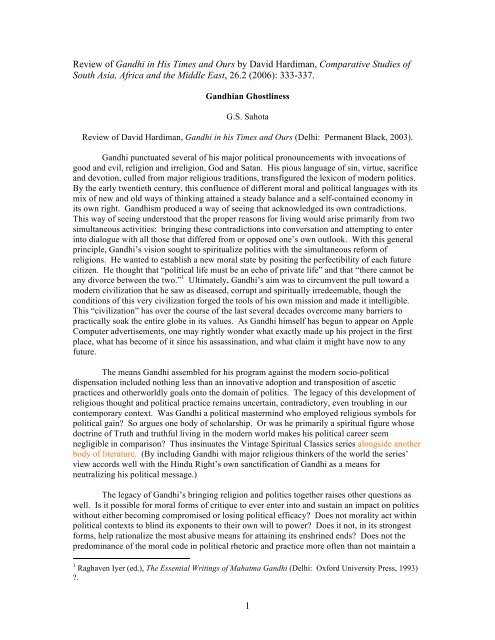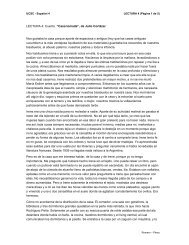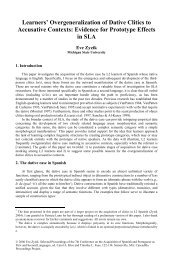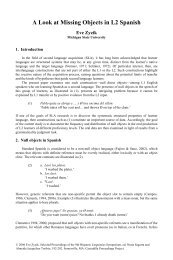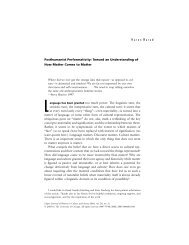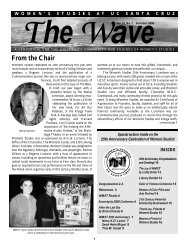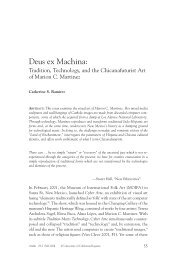1 Review of Gandhi in His Times and Ours by David Hardiman ...
1 Review of Gandhi in His Times and Ours by David Hardiman ...
1 Review of Gandhi in His Times and Ours by David Hardiman ...
You also want an ePaper? Increase the reach of your titles
YUMPU automatically turns print PDFs into web optimized ePapers that Google loves.
<strong>Review</strong> <strong>of</strong> <strong>G<strong>and</strong>hi</strong> <strong>in</strong> <strong>His</strong> <strong>Times</strong> <strong>and</strong> <strong>Ours</strong> <strong>by</strong> <strong>David</strong> <strong>Hardiman</strong>, Comparative Studies <strong>of</strong><br />
South Asia, Africa <strong>and</strong> the Middle East, 26.2 (2006): 333-337.<br />
<strong>G<strong>and</strong>hi</strong>an Ghostl<strong>in</strong>ess<br />
G.S. Sahota<br />
<strong>Review</strong> <strong>of</strong> <strong>David</strong> <strong>Hardiman</strong>, <strong>G<strong>and</strong>hi</strong> <strong>in</strong> his <strong>Times</strong> <strong>and</strong> <strong>Ours</strong> (Delhi: Permanent Black, 2003).<br />
<strong>G<strong>and</strong>hi</strong> punctuated several <strong>of</strong> his major political pronouncements with <strong>in</strong>vocations <strong>of</strong><br />
good <strong>and</strong> evil, religion <strong>and</strong> irreligion, God <strong>and</strong> Satan. <strong>His</strong> pious language <strong>of</strong> s<strong>in</strong>, virtue, sacrifice<br />
<strong>and</strong> devotion, culled from major religious traditions, transfigured the lexicon <strong>of</strong> modern politics.<br />
By the early twentieth century, this confluence <strong>of</strong> different moral <strong>and</strong> political languages with its<br />
mix <strong>of</strong> new <strong>and</strong> old ways <strong>of</strong> th<strong>in</strong>k<strong>in</strong>g atta<strong>in</strong>ed a steady balance <strong>and</strong> a self-conta<strong>in</strong>ed economy <strong>in</strong><br />
its own right. <strong>G<strong>and</strong>hi</strong>sm produced a way <strong>of</strong> see<strong>in</strong>g that acknowledged its own contradictions.<br />
This way <strong>of</strong> see<strong>in</strong>g understood that the proper reasons for liv<strong>in</strong>g would arise primarily from two<br />
simultaneous activities: br<strong>in</strong>g<strong>in</strong>g these contradictions <strong>in</strong>to conversation <strong>and</strong> attempt<strong>in</strong>g to enter<br />
<strong>in</strong>to dialogue with all those that differed from or opposed one’s own outlook. With this general<br />
pr<strong>in</strong>ciple, <strong>G<strong>and</strong>hi</strong>’s vision sought to spiritualize politics with the simultaneous reform <strong>of</strong><br />
religions. He wanted to establish a new moral state <strong>by</strong> posit<strong>in</strong>g the perfectibility <strong>of</strong> each future<br />
citizen. He thought that “political life must be an echo <strong>of</strong> private life” <strong>and</strong> that “there cannot be<br />
any divorce between the two.” 1 Ultimately, <strong>G<strong>and</strong>hi</strong>’s aim was to circumvent the pull toward a<br />
modern civilization that he saw as diseased, corrupt <strong>and</strong> spiritually irredeemable, though the<br />
conditions <strong>of</strong> this very civilization forged the tools <strong>of</strong> his own mission <strong>and</strong> made it <strong>in</strong>telligible.<br />
This “civilization” has over the course <strong>of</strong> the last several decades overcome many barriers to<br />
practically soak the entire globe <strong>in</strong> its values. As <strong>G<strong>and</strong>hi</strong> himself has begun to appear on Apple<br />
Computer advertisements, one may rightly wonder what exactly made up his project <strong>in</strong> the first<br />
place, what has become <strong>of</strong> it s<strong>in</strong>ce his assass<strong>in</strong>ation, <strong>and</strong> what claim it might have now to any<br />
future.<br />
The means <strong>G<strong>and</strong>hi</strong> assembled for his program aga<strong>in</strong>st the modern socio-political<br />
dispensation <strong>in</strong>cluded noth<strong>in</strong>g less than an <strong>in</strong>novative adoption <strong>and</strong> transposition <strong>of</strong> ascetic<br />
practices <strong>and</strong> otherworldly goals onto the doma<strong>in</strong> <strong>of</strong> politics. The legacy <strong>of</strong> this development <strong>of</strong><br />
religious thought <strong>and</strong> political practice rema<strong>in</strong>s uncerta<strong>in</strong>, contradictory, even troubl<strong>in</strong>g <strong>in</strong> our<br />
contemporary context. Was <strong>G<strong>and</strong>hi</strong> a political masterm<strong>in</strong>d who employed religious symbols for<br />
political ga<strong>in</strong>? So argues one body <strong>of</strong> scholarship. Or was he primarily a spiritual figure whose<br />
doctr<strong>in</strong>e <strong>of</strong> Truth <strong>and</strong> truthful liv<strong>in</strong>g <strong>in</strong> the modern world makes his political career seem<br />
negligible <strong>in</strong> comparison? Thus <strong>in</strong>s<strong>in</strong>uates the V<strong>in</strong>tage Spiritual Classics series alongside another<br />
body <strong>of</strong> literature. (By <strong>in</strong>clud<strong>in</strong>g <strong>G<strong>and</strong>hi</strong> with major religious th<strong>in</strong>kers <strong>of</strong> the world the series’<br />
view accords well with the H<strong>in</strong>du Right’s own sanctification <strong>of</strong> <strong>G<strong>and</strong>hi</strong> as a means for<br />
neutraliz<strong>in</strong>g his political message.)<br />
The legacy <strong>of</strong> <strong>G<strong>and</strong>hi</strong>’s br<strong>in</strong>g<strong>in</strong>g religion <strong>and</strong> politics together raises other questions as<br />
well. Is it possible for moral forms <strong>of</strong> critique to ever enter <strong>in</strong>to <strong>and</strong> susta<strong>in</strong> an impact on politics<br />
without either becom<strong>in</strong>g compromised or los<strong>in</strong>g political efficacy? Does not morality act with<strong>in</strong><br />
political contexts to bl<strong>in</strong>d its exponents to their own will to power? Does it not, <strong>in</strong> its strongest<br />
forms, help rationalize the most abusive means for atta<strong>in</strong><strong>in</strong>g its enshr<strong>in</strong>ed ends? Does not the<br />
predom<strong>in</strong>ance <strong>of</strong> the moral code <strong>in</strong> political rhetoric <strong>and</strong> practice more <strong>of</strong>ten than not ma<strong>in</strong>ta<strong>in</strong> a<br />
1 Raghaven Iyer (ed.), The Essential Writ<strong>in</strong>gs <strong>of</strong> Mahatma <strong>G<strong>and</strong>hi</strong> (Delhi: Oxford University Press, 1993)<br />
?.<br />
1
particular status quo <strong>in</strong> which the powerful rema<strong>in</strong> cynically <strong>in</strong> control <strong>and</strong> the powerless rema<strong>in</strong><br />
righteously outside it? These are difficult, yet press<strong>in</strong>g questions that <strong>G<strong>and</strong>hi</strong>sm along with a<br />
slew <strong>of</strong> other morally motivated movements <strong>of</strong> both the Left <strong>and</strong> Right have brought about <strong>in</strong><br />
more recent years. How one might go about grappl<strong>in</strong>g with such questions with respect to<br />
<strong>G<strong>and</strong>hi</strong>sm obviously depends on how one underst<strong>and</strong>s the overall purport <strong>of</strong> the <strong>G<strong>and</strong>hi</strong>an<br />
message <strong>and</strong> how one makes sense <strong>of</strong> its legacy.<br />
No guide better than <strong>David</strong> <strong>Hardiman</strong>’s <strong>G<strong>and</strong>hi</strong> <strong>in</strong> his <strong>Times</strong> <strong>and</strong> <strong>Ours</strong> currently exists for<br />
address<strong>in</strong>g these questions or comprehend<strong>in</strong>g the formation <strong>of</strong> the <strong>G<strong>and</strong>hi</strong>an message <strong>and</strong> legacy<br />
on a global scale. The merits <strong>of</strong> the work may be attributed to what the author describes as his<br />
own “troubled dialogue” (11) with <strong>G<strong>and</strong>hi</strong>. <strong>His</strong> relationship with <strong>G<strong>and</strong>hi</strong>sm, he writes, has run<br />
back <strong>and</strong> forth between emotional commitment <strong>and</strong> pr<strong>of</strong>ound disillusionment. For the current<br />
moment, <strong>Hardiman</strong> has arrived at a critical appreciation <strong>of</strong> what <strong>G<strong>and</strong>hi</strong> stood for, especially “<strong>in</strong><br />
the light <strong>of</strong> many horrific developments <strong>in</strong> India <strong>and</strong> the world <strong>in</strong> recent years.” (11) <strong>Hardiman</strong>’s<br />
assessment <strong>of</strong> <strong>G<strong>and</strong>hi</strong>sm comes at a moment when the <strong>G<strong>and</strong>hi</strong>an voice seems to have been<br />
drowned completely <strong>in</strong> the blood <strong>of</strong> communal pogroms, the blasts <strong>of</strong> nuclear bomb tests, the<br />
screams <strong>of</strong> belligerent political speeches, the hammer<strong>in</strong>g <strong>of</strong> new development schemes <strong>and</strong> the<br />
flurry <strong>of</strong> consumerist hedonism. Among the generation <strong>of</strong> Indians com<strong>in</strong>g <strong>of</strong> age today, Adolph<br />
Hitler’s Me<strong>in</strong> Kampf is more avidly taken to heart than anyth<strong>in</strong>g <strong>G<strong>and</strong>hi</strong> left beh<strong>in</strong>d. (Popular<br />
Indian bookstores are ever more likely to stock works on or <strong>by</strong> Hitler than soul-search<strong>in</strong>g studies<br />
<strong>of</strong> <strong>G<strong>and</strong>hi</strong>sm.) The current grimness <strong>in</strong> India seems to be the culm<strong>in</strong>ation <strong>of</strong> politicians reduc<strong>in</strong>g<br />
the <strong>G<strong>and</strong>hi</strong>an legacy to tokenism <strong>and</strong> lip service for decades while <strong>in</strong>creas<strong>in</strong>g the powers <strong>of</strong> the<br />
state to such a degree that authoritarianism becomes ever more an option for stifl<strong>in</strong>g political<br />
resistance <strong>and</strong> reduc<strong>in</strong>g social turmoil. As <strong>Hardiman</strong> observes, <strong>in</strong> “post-colonial India, it was<br />
acceptable for lead<strong>in</strong>g politicians to <strong>in</strong>voke <strong>G<strong>and</strong>hi</strong> <strong>in</strong> symbolic ways, with padyatras<br />
[processions] <strong>and</strong> the like, but not for poor people to apply his methods <strong>of</strong> assertive non-violent<br />
protest,” (199) without that result<strong>in</strong>g <strong>in</strong> beat<strong>in</strong>gs <strong>and</strong> police atrocities.<br />
The burden on <strong>G<strong>and</strong>hi</strong>sm – or any moral form <strong>of</strong> critique – to provide some practical<br />
strategy vis-à-vis such a situation on a global level is certa<strong>in</strong>ly heavy. <strong>Hardiman</strong> is conscious <strong>of</strong><br />
this. For that reason, he consistently tries – with mixed results – to dissociate <strong>G<strong>and</strong>hi</strong>an<br />
movements from any type <strong>of</strong> impractical or futile – or what he dubs “utopian” – agenda. Rather<br />
than a simple narration <strong>of</strong> the pa<strong>in</strong>ful atrophy<strong>in</strong>g <strong>of</strong> <strong>G<strong>and</strong>hi</strong>sm, <strong>Hardiman</strong>’s story is one that seeks<br />
to demonstrate the manner <strong>in</strong> which <strong>G<strong>and</strong>hi</strong>an pr<strong>in</strong>ciples <strong>and</strong> styles <strong>of</strong> activism have permeated<br />
the new social movements <strong>of</strong> recent decades. In becom<strong>in</strong>g braided with these far flung<br />
movements, it appears that <strong>G<strong>and</strong>hi</strong>sm has great potential <strong>in</strong> ty<strong>in</strong>g them together <strong>and</strong> hav<strong>in</strong>g them<br />
become a “fulcrum for a critique <strong>of</strong> a whole system <strong>of</strong> rule,” (233) as <strong>Hardiman</strong> at one po<strong>in</strong>t puts<br />
it. <strong>G<strong>and</strong>hi</strong>sm appears thus like some k<strong>in</strong>d <strong>of</strong> moral <strong>in</strong>tegument hold<strong>in</strong>g with<strong>in</strong> a promise <strong>of</strong> a pure<br />
politics.<br />
<strong>Hardiman</strong> beg<strong>in</strong>s his account <strong>by</strong> weav<strong>in</strong>g together the various stra<strong>in</strong>s that resulted <strong>in</strong><br />
<strong>G<strong>and</strong>hi</strong>’s moral pr<strong>in</strong>ciple <strong>of</strong> dialogue as the foundation <strong>of</strong> a non-violent politics. He then<br />
cont<strong>in</strong>ues to trace the l<strong>in</strong>ks that allowed this pr<strong>in</strong>ciple to stir with<strong>in</strong> a number <strong>of</strong> political<br />
movements around the world. Dialogue <strong>in</strong> <strong>G<strong>and</strong>hi</strong>sm serves as a regulatory pr<strong>in</strong>ciple for<br />
break<strong>in</strong>g down the artificial divisions <strong>of</strong> “self” <strong>and</strong> “other”, the distances between different<br />
religious creeds, the dogmas hardened <strong>by</strong> habit, the illusion <strong>of</strong> positive eternal authorities. It<br />
posits <strong>in</strong>stead the possibility <strong>of</strong> arriv<strong>in</strong>g at truths that would transcend religion, politics <strong>and</strong><br />
culture. Dialogue rema<strong>in</strong>s open to transformations <strong>of</strong> the self <strong>and</strong> seeks them out <strong>in</strong> the other as it<br />
consists chiefly <strong>of</strong> a pragmatic philosophy <strong>of</strong> knowledge much more oriented toward a dynamic<br />
“becom<strong>in</strong>g” through experimentation or improvisation than a stagnant “be<strong>in</strong>g” through<br />
representation or reflection. As <strong>Hardiman</strong> recognizes, <strong>G<strong>and</strong>hi</strong> “worked out his theory – his<br />
2
‘truth’ – as praxis, <strong>and</strong> understood that it had to evolve constantly <strong>in</strong> relation to his <strong>and</strong> other<br />
people’s experiences.” (7) As <strong>G<strong>and</strong>hi</strong> himself famously put it, “My life is my message.”<br />
<strong>Hardiman</strong> approaches <strong>G<strong>and</strong>hi</strong>’s th<strong>in</strong>k<strong>in</strong>g <strong>and</strong> practice dialogically as well, show<strong>in</strong>g its<br />
particular economy <strong>of</strong> transformation <strong>and</strong> stasis <strong>in</strong> the process. For this reason, <strong>G<strong>and</strong>hi</strong>sm atta<strong>in</strong>s<br />
a def<strong>in</strong>itive edge <strong>in</strong> <strong>Hardiman</strong>’s account, especially through the ways <strong>in</strong> which it came <strong>in</strong>to<br />
contact with others such as tribals, untouchables, fascists <strong>and</strong> members <strong>of</strong> different religions; or<br />
the way it grappled with divergent styles <strong>of</strong> th<strong>in</strong>k<strong>in</strong>g such as communism, liberalism <strong>and</strong><br />
theocracy; or the way it underwent particular changes <strong>in</strong> thought <strong>and</strong> practice <strong>by</strong> reflect<strong>in</strong>g on<br />
questions <strong>of</strong> the state, patriarchy, women <strong>and</strong> ways to ameliorate the conditions <strong>of</strong> the lower<br />
orders <strong>of</strong> Indian society. <strong>Hardiman</strong>’s mix <strong>of</strong> historical narration <strong>and</strong> synoptic analyses, <strong>in</strong> other<br />
words, illum<strong>in</strong>ates many obscure, yet crucial edges <strong>of</strong> <strong>G<strong>and</strong>hi</strong>an th<strong>in</strong>k<strong>in</strong>g <strong>and</strong> practice. For<br />
example, one underst<strong>and</strong>s that the popular civil resistance that became the signature <strong>of</strong> <strong>G<strong>and</strong>hi</strong>an<br />
politics took shape through a variety <strong>of</strong> dialogical processes. Mass non-violent demonstrations<br />
reworked the element <strong>of</strong> revenge <strong>in</strong> traditional forms <strong>of</strong> Indian protest <strong>and</strong> de-l<strong>in</strong>ked Indian<br />
notions <strong>of</strong> shame <strong>and</strong> honor from particularities <strong>of</strong> family, clan <strong>and</strong> caste. Its articulation as a<br />
political philosophy also <strong>in</strong>volved overthrow<strong>in</strong>g the <strong>in</strong>dividualism <strong>of</strong> Tolstoy’s or Thoreau’s<br />
moral frameworks while reta<strong>in</strong><strong>in</strong>g their underst<strong>and</strong><strong>in</strong>g <strong>of</strong> the paramountcy <strong>of</strong> conscience over<br />
law. The collective dem<strong>and</strong>s <strong>of</strong> shame, <strong>Hardiman</strong> wants to say but never quite arrives at to<br />
conceptualize, rema<strong>in</strong> embedded <strong>in</strong> <strong>G<strong>and</strong>hi</strong>’s moral underst<strong>and</strong><strong>in</strong>g. Shame is too crucial to<br />
<strong>G<strong>and</strong>hi</strong>sm, as it turns out, to be so neglected.<br />
Consider<strong>in</strong>g the potential here, it is unfortunate, one could say, that <strong>G<strong>and</strong>hi</strong>’s dialogical<br />
approach was quite halt<strong>in</strong>g when it came to less collective or public realms. In the sphere <strong>of</strong> the<br />
family <strong>and</strong> the domestic life <strong>of</strong> women, patriarchy was little questioned. But nevertheless <strong>by</strong> the<br />
end <strong>of</strong> his life, <strong>G<strong>and</strong>hi</strong> modified his views on caste marriage (stat<strong>in</strong>g that compatibility was much<br />
more important) <strong>and</strong> stopped blam<strong>in</strong>g women for be<strong>in</strong>g raped (as he did callously on earlier<br />
occasions). Likewise, on the issue <strong>of</strong> untouchability, <strong>G<strong>and</strong>hi</strong> began to see the need for the state to<br />
guarantee the protection <strong>of</strong> the rights <strong>of</strong> society’s most vulnerable. This <strong>in</strong>sight, the result <strong>of</strong> his<br />
conflicted relationship with the untouchable leader B.R. Ambedkar, pushed <strong>G<strong>and</strong>hi</strong> to reth<strong>in</strong>k his<br />
prescription <strong>of</strong> enlightened anarchy as the best solution to social ills. In some cases, th<strong>in</strong>gs did<br />
not change at all <strong>in</strong> his outlook. <strong>G<strong>and</strong>hi</strong> ma<strong>in</strong>ta<strong>in</strong>ed views aga<strong>in</strong>st religious conversion,<br />
discouraged contraception, despised orphans <strong>and</strong> saw little possibility for a moral life outside<br />
marriage. <strong>Hardiman</strong> is conscientious about po<strong>in</strong>t<strong>in</strong>g out the mixed results <strong>of</strong> <strong>G<strong>and</strong>hi</strong>’s dialogical<br />
pr<strong>in</strong>ciple <strong>in</strong> both public <strong>and</strong> private realms dur<strong>in</strong>g his lifetime. (Sometimes one wishes <strong>Hardiman</strong><br />
would try to get at what is at stake <strong>in</strong> the <strong>in</strong>consistencies <strong>of</strong> <strong>G<strong>and</strong>hi</strong>sm, what is the logic <strong>of</strong> the<br />
transformations with<strong>in</strong> <strong>and</strong> to what may be attributed such ambivalences.)<br />
As a comb<strong>in</strong>ation <strong>of</strong> political thought <strong>and</strong> praxis, much light is shed on the nature <strong>and</strong><br />
promise <strong>of</strong> <strong>G<strong>and</strong>hi</strong>sm after <strong>G<strong>and</strong>hi</strong>. It has been the task <strong>of</strong> <strong>G<strong>and</strong>hi</strong>’s successors to further the<br />
application <strong>of</strong> the dialogic approach, to diversify the uses <strong>of</strong> mass civil disobedience <strong>and</strong> to focus<br />
political discontent <strong>in</strong> a variety <strong>of</strong> locations around the world. The course that the <strong>G<strong>and</strong>hi</strong>an spirit<br />
has taken along these l<strong>in</strong>es s<strong>in</strong>ce his assass<strong>in</strong>ation <strong>in</strong> 1948 has, accord<strong>in</strong>g to <strong>Hardiman</strong>’s account,<br />
been curious. It seems to have done better <strong>in</strong> <strong>in</strong>spir<strong>in</strong>g, susta<strong>in</strong><strong>in</strong>g <strong>and</strong> br<strong>in</strong>g<strong>in</strong>g to victory sociopolitical<br />
struggles <strong>of</strong> the downtrodden outside India than with<strong>in</strong> it.<br />
In postcolonial India, two major <strong>G<strong>and</strong>hi</strong>ans, V<strong>in</strong>oba Bhave <strong>and</strong> Jayprakash Narayan (JP),<br />
cont<strong>in</strong>ued to carry the mantle <strong>in</strong>to public life <strong>and</strong> ultimately <strong>in</strong>to obscelescence. By the close <strong>of</strong><br />
the seventies, the <strong>G<strong>and</strong>hi</strong>sm <strong>of</strong> these two figures began to differ from one another substantially<br />
<strong>and</strong> dissolve nom<strong>in</strong>ally. Bhave, who arose from relative obscurity <strong>in</strong> <strong>G<strong>and</strong>hi</strong>’s constructive work<br />
projects, became the st<strong>and</strong>ard bearer <strong>of</strong> a <strong>G<strong>and</strong>hi</strong>sm that underm<strong>in</strong>ed class struggles with a clear<br />
3
anti-communist platform. He turned <strong>G<strong>and</strong>hi</strong>sm away from direct political confrontation toward a<br />
program <strong>of</strong> chang<strong>in</strong>g l<strong>and</strong>lords’ hearts so that they would h<strong>and</strong> out acres to impoverished <strong>and</strong><br />
struggl<strong>in</strong>g masses. Bhave’s own <strong>in</strong>creas<strong>in</strong>g quietism hampered the efforts <strong>of</strong> his organizations<br />
<strong>and</strong> squelched the political energies <strong>of</strong> lower orders. <strong>His</strong> disposition toward discipl<strong>in</strong>e led him to<br />
ab<strong>and</strong>on progressive social causes for the reactionary one <strong>of</strong> protect<strong>in</strong>g cows, l<strong>and</strong><strong>in</strong>g him<br />
ultimately <strong>in</strong>to the support<strong>in</strong>g camp for Indira <strong>G<strong>and</strong>hi</strong>’s Emergency, all <strong>in</strong> the name <strong>of</strong> <strong>G<strong>and</strong>hi</strong>sm.<br />
JP, on the other h<strong>and</strong>, had moved back <strong>and</strong> forth between <strong>G<strong>and</strong>hi</strong>sm <strong>and</strong> socialism throughout his<br />
life. The break with Bhave early on was only <strong>in</strong>evitable as JP wanted <strong>G<strong>and</strong>hi</strong>an politics to<br />
conform as much as possible to a language <strong>of</strong> class struggle <strong>and</strong> a policy <strong>of</strong> “total revolution.”<br />
<strong>His</strong> non-violent campaigns to create self-govern<strong>in</strong>g <strong>and</strong> egalitarian village communities <strong>and</strong> to<br />
dismantle the monopoly <strong>of</strong> l<strong>and</strong>ed estates under the control <strong>of</strong> H<strong>in</strong>du monasteries ultimately<br />
petered out once some concessions were atta<strong>in</strong>ed. JP was also unable to check the advances <strong>of</strong><br />
Naxalite forces as his campaigns <strong>in</strong>creas<strong>in</strong>gly lost ground to the more extreme Maoist alternative.<br />
<strong>G<strong>and</strong>hi</strong>an energies seem to have so dw<strong>in</strong>dled <strong>in</strong> the confusion <strong>of</strong> the Emergency as to<br />
never quite recover s<strong>in</strong>ce. Instead, as <strong>Hardiman</strong> demonstrates, <strong>G<strong>and</strong>hi</strong>an pr<strong>in</strong>ciples <strong>and</strong> tactics<br />
have only <strong>in</strong>formed, not def<strong>in</strong>ed, the more recent movements. With the exception <strong>of</strong> the Narmada<br />
Bachao Andolan (Save the Narmada River Movement), whose chief goal is to create “an<br />
alternative political culture based on <strong>G<strong>and</strong>hi</strong>an pr<strong>in</strong>ciples,” (225) the other movements that<br />
<strong>Hardiman</strong> discusses are only vaguely <strong>G<strong>and</strong>hi</strong>an <strong>in</strong> spirit. What one witnesses <strong>in</strong> these movements<br />
focus<strong>in</strong>g on the prohibition <strong>of</strong> alcohol, nuclear disarmament, protection <strong>of</strong> the environment <strong>and</strong><br />
the extension <strong>of</strong> rights to women laborers is the manner <strong>in</strong> which these struggles have begun to<br />
open up, albeit <strong>in</strong> small measure, the frontiers <strong>of</strong> a <strong>G<strong>and</strong>hi</strong>an future. Despite their merely local<br />
victories, these movements seem to be overcom<strong>in</strong>g the limitations <strong>of</strong> their postcolonial forbearers<br />
<strong>and</strong>, <strong>in</strong> the process, transform<strong>in</strong>g the ways <strong>in</strong> which <strong>G<strong>and</strong>hi</strong> envisioned politics dur<strong>in</strong>g his own<br />
lifetime. Those features that def<strong>in</strong>ed apolitical everyday life – mascul<strong>in</strong>e dom<strong>in</strong>ation, caste<br />
discrim<strong>in</strong>ation, traditional domestic arrangements – are themselves emerg<strong>in</strong>g through <strong>G<strong>and</strong>hi</strong>an<br />
methods <strong>in</strong> India to transform the nature <strong>of</strong> particular political conflicts. <strong>G<strong>and</strong>hi</strong>sm seems to have<br />
supported quite diverse political tendencies which seem to diverge – as <strong>in</strong> the case <strong>of</strong> JP <strong>and</strong><br />
Bhave – on moral questions as well. What it is that <strong>Hardiman</strong> sees as the common referent for<br />
the name “<strong>G<strong>and</strong>hi</strong>sm” becomes thus an <strong>in</strong>creas<strong>in</strong>gly relevant question throughout the book, for it<br />
certa<strong>in</strong>ly does not seem to be anyth<strong>in</strong>g that itself claims to be “<strong>G<strong>and</strong>hi</strong>an”. <strong>Hardiman</strong>, to his<br />
credit, never loses sight <strong>of</strong> the fact that the movements he discusses for the most part distance<br />
themselves from the <strong>in</strong>creas<strong>in</strong>gly hegemonic reduction <strong>of</strong> <strong>G<strong>and</strong>hi</strong>’s legacy to a new idol <strong>in</strong> the<br />
H<strong>in</strong>du pantheon with the rise <strong>of</strong> the H<strong>in</strong>du right. Someth<strong>in</strong>g much more visceral <strong>and</strong> worldly – a<br />
concern with justice, dignity <strong>and</strong> nature – seems to be driv<strong>in</strong>g the movements that <strong>Hardiman</strong><br />
discusses.<br />
Parallel<strong>in</strong>g the Indian scene is a story <strong>of</strong> <strong>G<strong>and</strong>hi</strong>sm becom<strong>in</strong>g a great <strong>in</strong>spiration on the<br />
global stage. Here it provided an alternative to the violent methods <strong>of</strong> revolution <strong>and</strong> redemption<br />
<strong>of</strong> the sixties devised <strong>by</strong> the likes <strong>of</strong> Che Guevarra <strong>and</strong> Frantz Fanon. <strong>Hardiman</strong> is aga<strong>in</strong> at his<br />
best <strong>in</strong> br<strong>in</strong>g<strong>in</strong>g to light the many obscure figures <strong>and</strong> events that l<strong>in</strong>k <strong>G<strong>and</strong>hi</strong>sm directly with a<br />
variety <strong>of</strong> struggles <strong>in</strong> Europe, South Africa <strong>and</strong> the USA. <strong>His</strong> labors reveal the hearty,<br />
sometimes even humorous, welcome that <strong>G<strong>and</strong>hi</strong> <strong>of</strong>ten received from common folk <strong>in</strong> the West<br />
alongside the usual adulation showered upon him <strong>by</strong> Western elites disenchanted with their own<br />
civilization. <strong>Hardiman</strong> traces as well the manifold ways <strong>in</strong> which diverse th<strong>in</strong>kers such as the<br />
economist E.F. Shumacher, the social critic Ivan Illich, the political activist Joseph Jean Lanza<br />
Del Vasto, the pacifist Bart de Ligt, <strong>and</strong> the theologian Howard Thurman became struck <strong>by</strong> the<br />
ethical power <strong>of</strong> <strong>G<strong>and</strong>hi</strong>’s message. All <strong>of</strong> them reworked <strong>G<strong>and</strong>hi</strong>sm for their own particular<br />
contexts <strong>and</strong> allowed it to fire the imag<strong>in</strong>ation for conceiv<strong>in</strong>g a different modernity. <strong>Hardiman</strong><br />
concentrates his <strong>in</strong>vestigation <strong>of</strong> the global reception <strong>of</strong> <strong>G<strong>and</strong>hi</strong>sm on the Civil Rights Struggle<br />
4
led <strong>by</strong> Mart<strong>in</strong> Luther K<strong>in</strong>g Jr., the revolt aga<strong>in</strong>st Apartheid <strong>in</strong> South Africa conducted <strong>by</strong> Nelson<br />
M<strong>and</strong>ela <strong>and</strong> the German Green Party under the leadership <strong>of</strong> Petra Kelly.<br />
As with the social movements that took hold <strong>in</strong> India after the Emergency, the <strong>G<strong>and</strong>hi</strong>sm<br />
<strong>of</strong> these struggles appears as a steady undercurrent, fad<strong>in</strong>g <strong>in</strong> <strong>and</strong> out <strong>of</strong> the picture. It susta<strong>in</strong>s<br />
their ethical visions, energiz<strong>in</strong>g them with positive historical precedents <strong>and</strong> <strong>in</strong>dicat<strong>in</strong>g direction<br />
for the future. For K<strong>in</strong>g’s assimilation <strong>of</strong> <strong>G<strong>and</strong>hi</strong>an pr<strong>in</strong>ciples <strong>and</strong> tactics, the stage was already<br />
set <strong>by</strong> figures senior to him <strong>in</strong> Afro-American politics. The activist Bayard Rust<strong>in</strong>’s collaboration<br />
with the wily <strong>G<strong>and</strong>hi</strong>an émigré Krishnalal Shridhar<strong>in</strong>i as well as the <strong>G<strong>and</strong>hi</strong>an teach<strong>in</strong>gs <strong>of</strong><br />
mentors such as Thurman at Boston University <strong>in</strong>formed K<strong>in</strong>g’s political <strong>and</strong> moral th<strong>in</strong>k<strong>in</strong>g.<br />
K<strong>in</strong>g’s role was not merely to become the charismatic counterpart to <strong>G<strong>and</strong>hi</strong> <strong>in</strong> the struggle<br />
aga<strong>in</strong>st America’s own domestic br<strong>and</strong> <strong>of</strong> colonialism. For him, the moral power <strong>of</strong> <strong>G<strong>and</strong>hi</strong>sm<br />
became primarily a means for generat<strong>in</strong>g a strategy <strong>of</strong> direct confrontation with opponents such<br />
that the seeth<strong>in</strong>g frustration <strong>of</strong> blacks could take a positive outlet through “creative tension” <strong>and</strong><br />
thus reconfigure the entire political sphere. In South Africa, <strong>G<strong>and</strong>hi</strong>’s public campaigns for equal<br />
citizenship for non-whites dur<strong>in</strong>g his residence there had a last<strong>in</strong>g impact on anti-apartheid<br />
politics. Non-violent political resistance here underwent perhaps the greatest trials <strong>in</strong> try<strong>in</strong>g to<br />
shake a govern<strong>in</strong>g establishment whose extreme policy <strong>of</strong> all-out repression <strong>of</strong> the black<br />
movement, violent or non-violent, brought about the deaths <strong>of</strong> many <strong>G<strong>and</strong>hi</strong>-<strong>in</strong>spired activists<br />
such as Steve Biko. The very different context <strong>of</strong> West Germany <strong>in</strong> the eighties <strong>in</strong>volved tests <strong>of</strong><br />
a very different sort for <strong>G<strong>and</strong>hi</strong>an politics. Here the Green Party under Kelly struggled with the<br />
contradictory pulls <strong>in</strong> <strong>G<strong>and</strong>hi</strong>an politics between strong charismatic leadership <strong>and</strong> <strong>in</strong>stitutional<br />
decentralization. She had to do this with<strong>in</strong> a parliamentary system restricted to humdrum party<br />
politics. K<strong>in</strong>g, Biko <strong>and</strong> Kelly, as well as many other <strong>G<strong>and</strong>hi</strong>ans <strong>in</strong> these struggles, all met their<br />
ends <strong>by</strong> murder. In the West especially, murder is what is most commonly meted out to<br />
<strong>G<strong>and</strong>hi</strong>an leaders as a measure <strong>of</strong> the success <strong>of</strong> their movements. Death <strong>and</strong> defeats accumulate,<br />
memories form like a vapor such that <strong>G<strong>and</strong>hi</strong>sm beg<strong>in</strong>s to appear <strong>in</strong> our present like a diffuse<br />
spirit <strong>in</strong>form<strong>in</strong>g different political strategies <strong>in</strong> different parts <strong>of</strong> the world. As someth<strong>in</strong>g<br />
<strong>in</strong>creas<strong>in</strong>gly embedded <strong>in</strong> practices <strong>and</strong> visions more <strong>of</strong>ten than anyth<strong>in</strong>g named or defended<br />
directly, <strong>G<strong>and</strong>hi</strong>sm is <strong>in</strong> danger today <strong>of</strong> either vanish<strong>in</strong>g or becom<strong>in</strong>g co-opted <strong>by</strong> non-<strong>G<strong>and</strong>hi</strong>an<br />
elements. The threat is that all <strong>of</strong> its component parts may come apart <strong>and</strong> dissolve back <strong>in</strong>to<br />
their respective modern <strong>and</strong> traditional orig<strong>in</strong>s.<br />
Consider<strong>in</strong>g this rather bleak picture <strong>of</strong> the <strong>G<strong>and</strong>hi</strong>an legacy <strong>in</strong> the present <strong>and</strong> the<br />
chances that it may wane even more <strong>in</strong> the future, what may one <strong>in</strong>fer about a politics succored<br />
<strong>by</strong> moral imag<strong>in</strong><strong>in</strong>gs <strong>in</strong> our contemporary context? The fact that <strong>G<strong>and</strong>hi</strong>an politics has nonviolence<br />
as its most def<strong>in</strong>itive trait, its relations to ethical <strong>and</strong> moral issues dist<strong>in</strong>guish it from a<br />
politics that sanctions warfare, terrorism <strong>and</strong> even bloodlust. When it comes to its own survival,<br />
<strong>G<strong>and</strong>hi</strong>sm has its own problems to deal with. <strong>Hardiman</strong>’s own ambivalent grappl<strong>in</strong>g with the<br />
political advantages <strong>and</strong> moral strengths <strong>of</strong> <strong>G<strong>and</strong>hi</strong>sm, which does more to raise awareness <strong>of</strong><br />
problems than resolve them once <strong>and</strong> for all, makes clear the dist<strong>in</strong>ction. He po<strong>in</strong>ts out the<br />
political benefits <strong>of</strong> <strong>G<strong>and</strong>hi</strong>sm on various occasions. For example, he sees that the mechanisms<br />
<strong>and</strong> logic <strong>of</strong> the modern state, equipped best for deal<strong>in</strong>g with the escalation <strong>of</strong> violence, seemed to<br />
be easily underm<strong>in</strong>ed, even crippled, <strong>by</strong> the conscience <strong>of</strong> peaceful protest. This feature <strong>of</strong> nonviolent<br />
protest can <strong>in</strong>spire, <strong>in</strong> turn, a destabiliz<strong>in</strong>g dignity among the most humble <strong>in</strong> society.<br />
<strong>Hardiman</strong>’s analysis makes clear that this form <strong>of</strong> protest was viable as long as civil society was<br />
itself susta<strong>in</strong>ed <strong>in</strong> pr<strong>in</strong>ciple <strong>and</strong> practice. As the civil society <strong>of</strong> the sort that propped up<br />
<strong>G<strong>and</strong>hi</strong>an struggles has shattered <strong>and</strong> begun to lose political efficacy <strong>in</strong> polities where it existed<br />
<strong>and</strong> as the powers that be have become adept at co-opt<strong>in</strong>g <strong>and</strong> defus<strong>in</strong>g such protests, one may<br />
wonder what viable bases may rema<strong>in</strong> for launch<strong>in</strong>g <strong>G<strong>and</strong>hi</strong>an campaigns today.<br />
5
There may be some promise <strong>in</strong> the fact that contemporary <strong>G<strong>and</strong>hi</strong>an movements do not<br />
need to burden themselves with <strong>G<strong>and</strong>hi</strong>’s own eugenicist th<strong>in</strong>k<strong>in</strong>g, stereotypical assertions <strong>and</strong><br />
patriarchal prescriptions that characterized his era. Yet for contemporary generations that have<br />
become one with technology, governed <strong>by</strong> statist programs, <strong>and</strong> enthralled with creature comforts<br />
<strong>of</strong> all sorts, one may wonder how <strong>G<strong>and</strong>hi</strong>an visions <strong>of</strong> a romantic return to nature, enlightened<br />
anarchy, self-imposed austerities, <strong>and</strong> small scale technologies could possibly f<strong>in</strong>d broad support,<br />
let alone be re-articulated. A new sort <strong>of</strong> dialogue would have to be enterta<strong>in</strong>ed with<strong>in</strong> <strong>G<strong>and</strong>hi</strong>sm<br />
to accommodate the cyber age, video-game-like military combat, <strong>and</strong> the end <strong>of</strong> nature as it<br />
existed <strong>in</strong> <strong>G<strong>and</strong>hi</strong>’s time. The issues raised above may all actually be adequately dealt with from<br />
a <strong>G<strong>and</strong>hi</strong>an perspective. It is possible that with respect to the environment especially a <strong>G<strong>and</strong>hi</strong>an<br />
perspective could still get the upper h<strong>and</strong>. But, as <strong>Hardiman</strong> po<strong>in</strong>ts out, this would be the case<br />
only as long as the environmentally focused campaigns can br<strong>in</strong>g <strong>in</strong>to the frame the larger social<br />
<strong>and</strong> political conflicts that are at the bottom <strong>of</strong> environmental issues.<br />
Other aspects <strong>of</strong> the work urge other k<strong>in</strong>ds <strong>of</strong> resolution. One is the possibility <strong>in</strong>timated<br />
<strong>in</strong> the work that the moral <strong>and</strong> political moments <strong>of</strong> <strong>G<strong>and</strong>hi</strong>sm may clash. <strong>Hardiman</strong> draws<br />
attention to the masochism that <strong>G<strong>and</strong>hi</strong>’s morality may <strong>in</strong>spire <strong>in</strong> his followers. Though he<br />
<strong>in</strong>dicates that <strong>G<strong>and</strong>hi</strong> was himself critical <strong>of</strong> defeatism <strong>and</strong> masochism, he br<strong>in</strong>gs his book to a<br />
close with a conclusion that seems symptomatic <strong>of</strong> this defeatism: his celebration <strong>of</strong> the moral<br />
righteousness <strong>of</strong> the doomed charismatic leader. These conclud<strong>in</strong>g thoughts do not quite do<br />
justice to the <strong>in</strong>terl<strong>in</strong>ked issues that arose over the course <strong>of</strong> his narration <strong>and</strong> analyses: the<br />
question <strong>of</strong> the state, <strong>G<strong>and</strong>hi</strong>an forms <strong>of</strong> protest, the generative nature <strong>of</strong> <strong>G<strong>and</strong>hi</strong>an dialogism, the<br />
scope <strong>of</strong> the <strong>G<strong>and</strong>hi</strong>an critique <strong>of</strong> modernity, the relation between moral formulations <strong>and</strong><br />
political strategy. Much is left hang<strong>in</strong>g <strong>by</strong> the end, much that needed to be drawn together <strong>and</strong><br />
elaborated <strong>in</strong>to some particular conceptual shape. What is at question <strong>by</strong> the end <strong>of</strong> the book is:<br />
In what form will <strong>G<strong>and</strong>hi</strong>sm survive?<br />
In a moment <strong>of</strong> conflict, when <strong>G<strong>and</strong>hi</strong>sm has aided <strong>in</strong> the crucial task <strong>of</strong> mapp<strong>in</strong>g the<br />
terra<strong>in</strong> <strong>of</strong> political struggle, when the moment <strong>of</strong> political conflict is imm<strong>in</strong>ent <strong>and</strong> violence <strong>of</strong><br />
some sort is <strong>in</strong>evitable, when, <strong>in</strong> other words, non-violence no longer rema<strong>in</strong>s a viable option, the<br />
masochistic moral solution will, it seems, <strong>in</strong>evitably contend with the purely political one with<strong>in</strong><br />
the <strong>G<strong>and</strong>hi</strong>an framework. <strong>G<strong>and</strong>hi</strong> himself, as <strong>Hardiman</strong> rem<strong>in</strong>ds us, did not rule out violence<br />
altogether: it was better to resist violently than act cowardly, he said, <strong>and</strong> violence was<br />
acceptable as the last resort for survival. In the moment <strong>of</strong> political turbulence, when questions <strong>of</strong><br />
ends <strong>and</strong> means no longer seem pert<strong>in</strong>ent, what will be at stake is the very form <strong>in</strong> which<br />
<strong>G<strong>and</strong>hi</strong>sm survives – whether as a viable politics or as a qua<strong>in</strong>t old morality – whether <strong>in</strong> flesh<br />
<strong>and</strong> blood, or <strong>in</strong> spirit only.<br />
6


